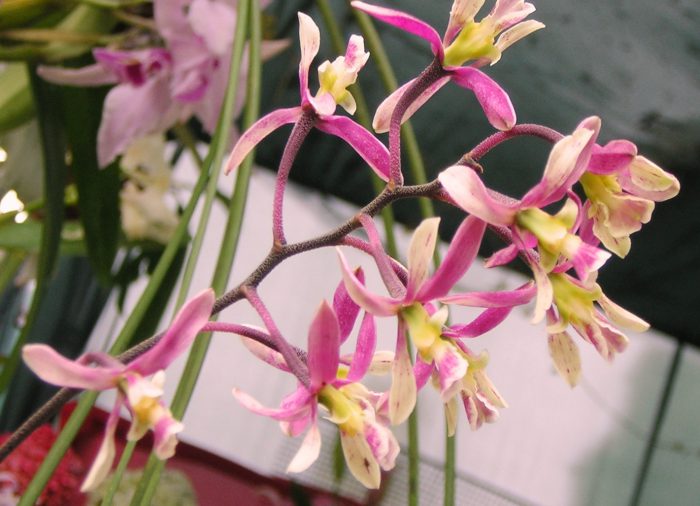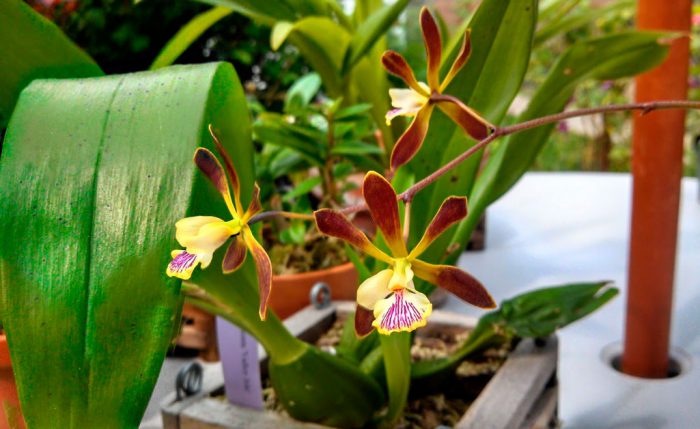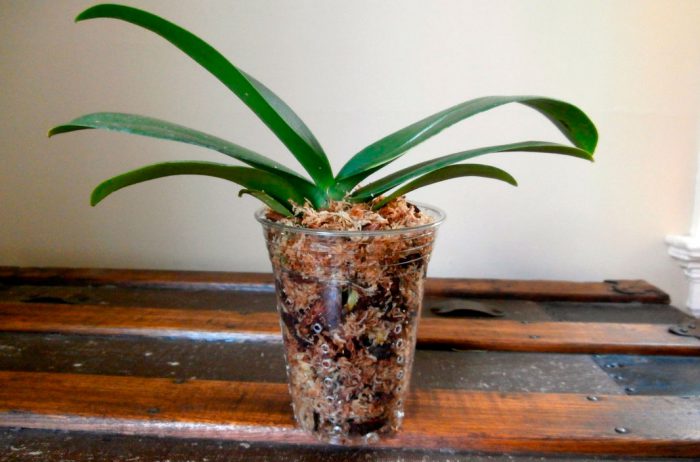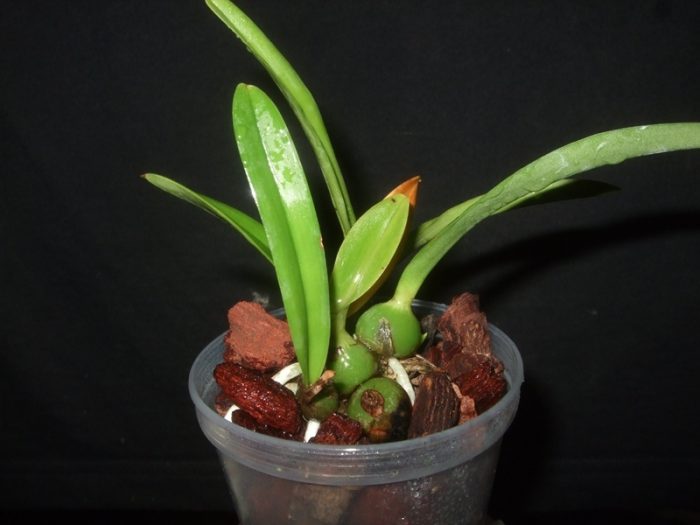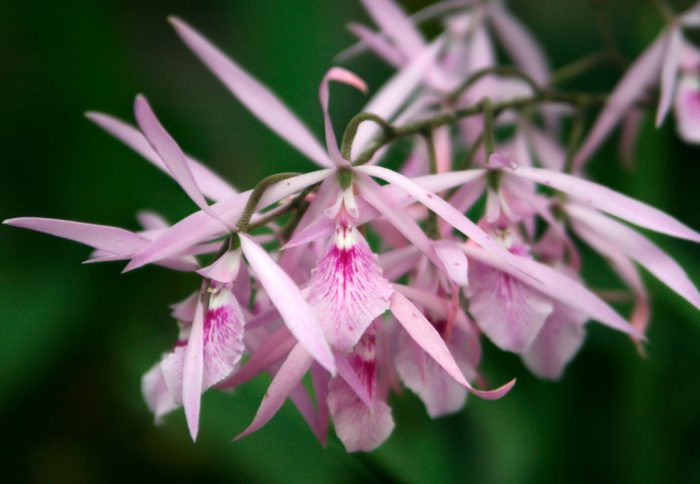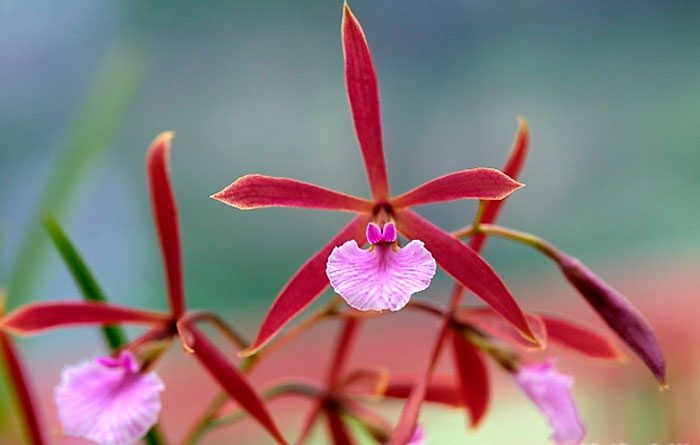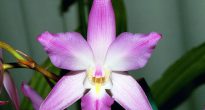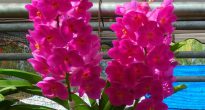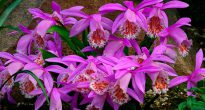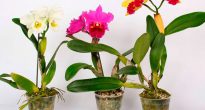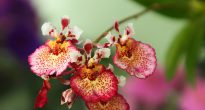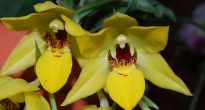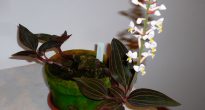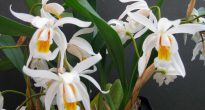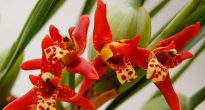Kind of like encyclia (Encyclia) is directly related to the orchid family. It unites more than 160 plant species, represented by lithophytes and epiphytes. In nature, they can be found in Central and South America.
The characteristic features of this genus are: the sympoidal nature of growth (this is when a young stem grows at the base of the old one), short rhizomes (creeping aerial shoot), two-leaved (sometimes one-, three- and four-leafed) pseudobulbs of a pear-shaped or ovoid shape. Thick leathery leaves have an elliptical-pointed or lanceolate shape, while the plate itself is slightly folded along the central vein.
The plant blooms for a long time. So, flowering can last for several weeks or several months. The apical peduncles may differ in different species. So, some species have single flowers of a fairly large size, while others have multi-flowered, highly branched inflorescences in the form of a brush. Pronounced zygomorphic flowers have 3 sepals (sepals) and 2 true petals (petals), which are very narrow and have a similar color and shape. A fairly large three-lobed lip (3rd true petal), free along the entire length, has a contrasting color. A pair of side pieces are often folded around the column, but they are not fused together.
Encyclical orchid care at home
This plant is quite unpretentious and is suitable for growing by both experienced and novice orchid growers.
Illumination
This genus of orchids requires very bright lighting. As a rule, it should be diffused at the same time, however, there are also types that can withstand the direct rays of the sun. But despite this, such flowers need shading from the scorching midday rays of the sun, otherwise burns may appear on the surface of the foliage.
It is preferable to put the flower pot on the window sill of a window with a south, west and east orientation. Regardless of which window the plant is located on, in autumn and winter it will need additional lighting with special phytolamps, while daylight hours should have a duration of 10 to 12 hours.
Temperature regime
Most of the species need a moderately warm or moderate temperature regime. In this case, the plant must provide a difference in daily temperatures. So, you need to try to ensure that throughout the year the temperature in the daytime is 18-22 degrees, and at night - from 13 to 16 degrees.Experienced growers recommend providing the encyclia with a daily temperature difference of approximately 5 degrees.
Under favorable weather conditions in the warm season (May – October), it is recommended to move the orchid outside. However, she needs to provide protection from gusts of wind, direct rays of the sun and precipitation. It is much easier to maintain the required temperature outside.
Earth mix
For the cultivation of such an orchid, both blocks and pots are used. Sphagnum, coniferous bark and small pieces of charcoal are used to fill the pot. A large piece of pine bark is taken as a block. On its surface, you need to fix the root system and the rhizome of the flower, while they should be wrapped in a not too thick layer of moss.
How to water
The plant is watered abundantly and frequently throughout the year. Watering should be done only after the bark is almost completely dry. There is a rather thick layer of velamen on the surface of the root system, and therefore it can withstand a short drought (do not make the dry period too long). It is recommended to water the encyclia not in the usual way, but to immerse the pot (block) in a basin filled with lukewarm water for 20-30 minutes. In this case, the water temperature should be about 30-35 degrees. This time is enough for the bark and roots to be saturated with moisture. After that, the plant must be removed and wait until the excess liquid drains. Then he is put in his usual place.
It should be watered with extremely soft water. You can filter it out or let it settle well.
Humidity
The plant does not need too high humidity. Optimum humidity should be between 50 and 70 percent. To increase the humidity, you can pour expanded clay into the pallet and pour in a little water, or put an open container filled with liquid next to it. If the humidity is very low, you can use a household humidifier or steam generator. Experienced flower growers advise to moisten the plant, bark, and moss from a sprayer at least 1 time per day.
Fertilizer
Such an orchid needs feeding all year round. They are carried out 1 time in 2 or 3 weeks. To do this, use special fertilizers for orchids, diluting them in water for irrigation, and take the dose that is indicated on the package.
Transplant features
Transplanted only as needed. So, this procedure is carried out if the container or block becomes small or in the case of acidification of the substrate and its decomposition.
Dormant period
The dormant period for this plant. He does not need it for abundant flowering and normal development. In the case when an outwardly healthy flower has not formed a single peduncle in 12 months, it will be necessary to artificially create a stressful situation for it. To do this, you must completely stop watering for 11-14 days, and also skip several fertilization procedures.
Reproduction methods
When grown indoors, you can propagate such an orchid by dividing the rhizome. It should be remembered that each division must necessarily have at least 3 mature pseudobulbs.
Propagated by seeds only in industrial conditions, they also use the cloning method (meristem reproduction).
Pests and diseases
The plant can settle spider mite... If this pest has been detected, then the flower should be given a warm shower (about 45 degrees), while thoroughly rinsing the foliage.
You can get sick if you violate the rules of care. So, rot may appear as a result of too frequent and plentiful watering, if watering is very sparse, the roots dry up, direct sunlight can leave burns on the foliage. Also, if there is poor lighting, then you are unlikely to wait for flowering.
Video review
Main types
Most types of encyclia are popular among flower growers, but hybrids of such a plant are even more in demand.
Encyclia glandular (Encyclia adenocaula)
This is the most beautiful species of all representatives of this genus. The flower itself is of medium size, mature pseudobulbs in height can reach from 5 to 7 centimeters. The leaves are quite long from 30 to 50 centimeters. A meter long peduncle is multiflorous. The fragrant flowers are large enough (up to 10 centimeters in diameter) painted in a delicate, pinkish-purple color. Sepals and petals have a narrow lanceolate shape. The triangular lip is rather wide, but at the central lobe, the lateral parts are bent downward, so it acquires a wedge-shaped shape. In the center of the lip there are dark purple longitudinal strokes, and at its base there is a snow-white speck.
Winged encyclia (Encyclia alata)
This plant has achieved particular popularity due to its fragrant flowers and undemanding care. It is large enough. So, the bush can reach a height of 1.5 meters, and a width of 0.5 meters. Multi-flowered peduncles have the same length as the bushes themselves. The flowers are relatively small, so they reach no more than 5-6.5 centimeters in diameter. Narrow yellowish-green sepals and petals are spatulate or obovate. In their upper part there are many small burgundy dots. At the lip, rather large whitish-yellow lateral parts have a wide-oval shape. On the triangular central part of the lip, there are longitudinal burgundy strokes, and its wavy edge is painted in a rich yellow color.
Encyclia bracts (Encyclia bractescens)
This dwarf species is very popular. It differs in that it can form rather dense and dense green colonies. The height of mature pseudobulbs is from 2 to 3 centimeters, and the leaves are linear-lanceolate, 40 centimeters long. Peduncles bear many flowers and they usually do not rise above the leaves. The small, fragrant flowers are only 2.5 centimeters in diameter. The sepals and petals are brownish-yellow and lanceolate. The wide spade-shaped lip is white. On its surface are longitudinal blurred veins of purple color.

